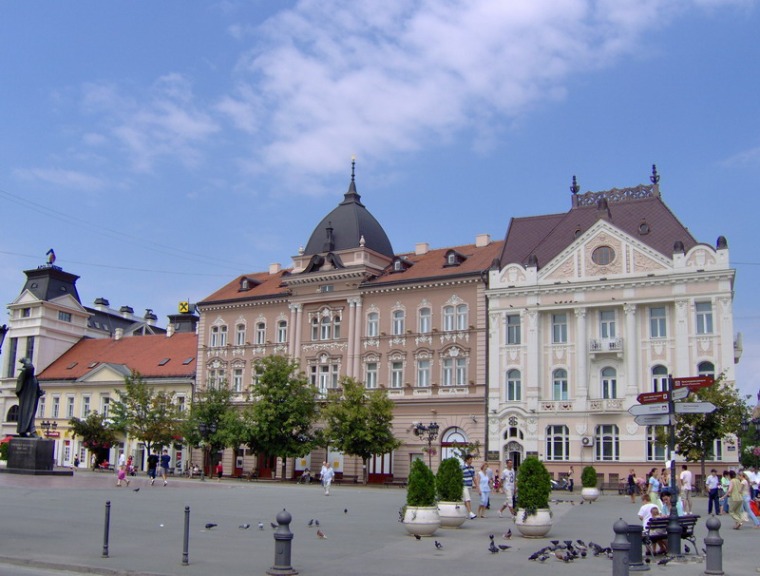A major cultural center in Vojvodina and one of the most beautiful cities in Serbia, Subotica was even the capital of a fairy-tale-like empire in the 16th century.
Through its long history Subotica often changed its rulers, countries and names. It has changed over 200 names – it was called Zabadka, Szent Maria, Maria Tereziopolis… It was under the governance of Hungarians, Turks, Serbs, and it was included in both Habsburg and Ottoman Empire, and then Yugoslavia. Once it was the capital of one almost fairy-tale empire.
Subotica passed a long way to being a Serbian most northern city. However, what remained the same during the course of all these centuries is the fact that it is a city worth being seen, a good place for a shorter of longer holiday, home of warmhearted and welcoming people of different nationalities who make Subotica look so charming and unique.
Subotica was inhabited since ancient times, and the traces of 3,000 years old settlements were found near the town. Centuries later, Subotica was first time mentioned in 1391 with its Hungarian name Zabadka, and it is assumed that today’s Hungarian name “Szabadka” meaning “dear, free place” comes from the previous name Zabadka.
While in Hungarian Subotica is “a dear place”, in Serbian it is “a little Saturday”. According to another legend, Subotica was named after Subota Vrlić – another prominent Serb, general and treasurer of self-proclaimed Emperor Jovan Nenad Crni (Jovan Nenad the Black).
An emperor?!
Yes. Subotica isn’t only a beautiful city with the one of the most beautiful lakes in Serbia – Palić, or host of the European Film Festival, Inter Ethno Festival or Wine Harvest Days…
As if its history wasn’t interesting enough, it was also the capital of one almost fairy-tale empire. The Emperor’s name was Jovan Nenad, and he got his nickname Crni (the black) by a black line going from his temple to his heel.
This mysterious person appeared after the defeat of Hungary at Mohač at the beginning of 16th century, when he managed to take parts of Bačka, Srem and Banat from Turks and establish a state that he soon proclaimed an empire and Subotica became its capital.
Nonetheless, this empire was not long-lived. It was destroyed by much more powerful empires and the empire and its emperor Nenad Crni (Nenad the Black) soon disappeared. But Subotica remained. Today there is a monument to its emperor at the central city’s square, for all those who don’t believe to this story.
One of the most beautiful cities in the region of Vojvodina is located only 10 kilometers from the border between Serbia and Hungary. Its position, between Europe and Asia, on the border between two great empires – Austro-Hungarian and Ottoman Empire, has significantly influenced the formation of this city. Since ancient times the city was inhabited by people of different nationalities and religions.
Today more than 20 ethnic minorities live here. It is home to 150,000 citizens, whose uniqueness turned Subotica into a true museum of different cultures and religions.
The city has one out of total three active synagogues in Serbia, a Protestant church, numerous Roman Catholic and Orthodox churches, as well as a newly built mosque. All these temples are also the traces of its rich culture, and the nearby Palić lake offers visitors the mixture of culture and natural beauties.
How to get to Subotica?
Subotica is 180km from Belgrade, 200km from Budapest and about 240km from Temišvar.
Subotica is about 2.5 hours drive from Belgrade international airport and at about the same distance from the Budapest and Timisoara airports.
It is easy to reach by car or bus from Belgrade or Budapest to this town, because the international road E-75 provides great access to the city. Regular buses provide connections with the whole of Serbia and most European countries.
Subotica is also connected with the rest Europe through important railroad connections by everyday international departures and arrivals.
When you are already here, don’t miss…
Enjoying the view of the fairy-tale architecture of Subotica while sitting in a café.
Try recognizing the elements of numerous cultures of different nationalities that live in Subotica and feel the harmony of their unity.
If you find yourself there in the beginning of may, don’t miss the “Trenchtown“- festival of alternative music and cultural on the lake Palić ethno camp, and in the second half of may don’t miss the “Palić Wine celebrations“.
Next to Palić, you should visit lake Ludaš, a protected natural area.
Enjoy the good wine, because you are on one of the nine wine routes of Serbia Palić wine route.
Related Articles
Exploring Belgrade Waterfront: Highlights and Must-See Attractions
December 11, 2024
From a Local Perspective: What to Visit and Not to Miss in Subotica
December 10, 2024





